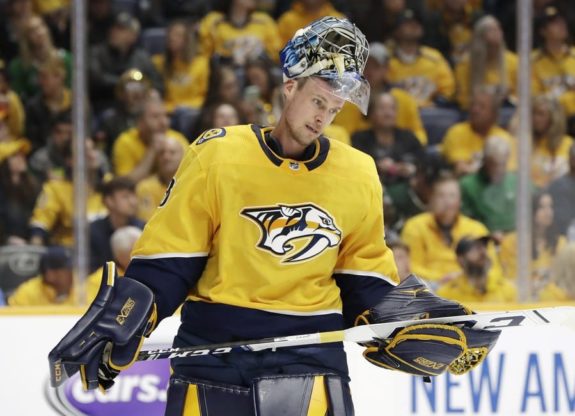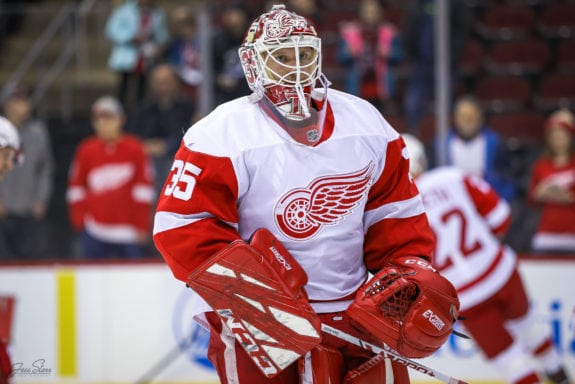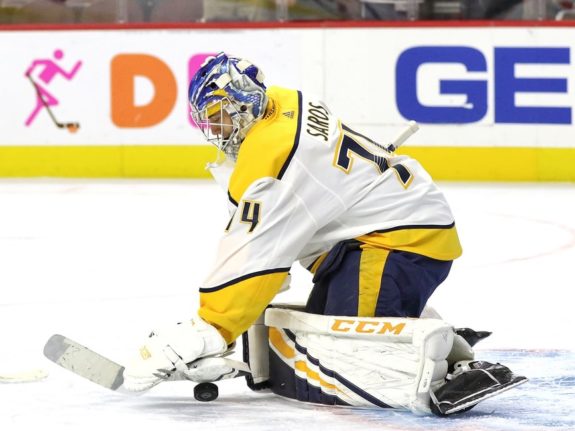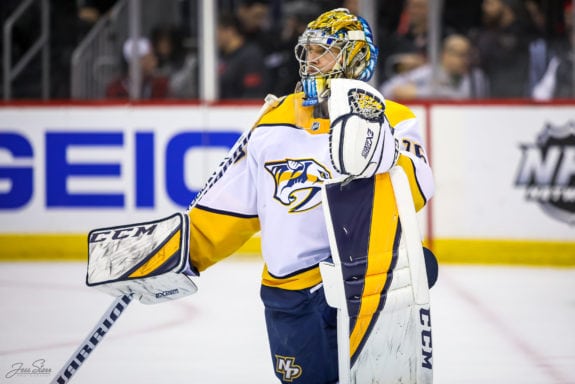Coming into the 2019-20 season, the Nashville Predators had arguably the most dynamic goaltender tandem in the NHL. Pekka Rinne, 37 years old, was solidified as their starter and one of the top goalies in the league, while talented backup Juuse Saros, 25 years old, was just on the horizon as Rinne’s replacement. It looked like it would be an easy and smooth transition from Rinne to Saros. At least, that’s what everyone had hoped for, but things do not always go as planned.
Related: Revisiting David Poile’s Drafts – 1998
Fast forward a year and the Predators have huge question marks surrounding their goaltending situation. Rinne was quite literally amongst the worst starters in the league while Saros had superb moments, but was inconsistent throughout the season. Over the course of this article, I will analyze each goalie’s production and what the Predators options are moving forward into next season and thereafter.
What Happened to Pekka Rinne?
This has not been the season that Rinne had wanted. Given his age, though, there was expected regression coming sooner or later, but I do not think anyone expected this much regression this quickly. He simply crumbled during the 2019 season and soon fell victim to Saros taking over as the starting goalie the second half of the season.

To get a quick glimpse of how Rinne faired this season compared to years past (Table 1), I compiled goalie statistics that are more telling of actual production rather than just looking at the standard goalie metrics such as save percentage (SV%) or goals-against average (GAA). Sports analytics have a bevy of uses but none more important than the fact that it allows you to view a particular player with stats that are more predictive of future success while excluding (team) variables, which tend to fog the player’s actual contribution to the team.
| Season | GPS* | GSAA** | QS%*** | GA%-^ |
| 2019-20 | 4.1 | -14.21 | .457 | 116 |
| 2018-19 | 10.1 | 12.50 | .545 | 91 |
| 2017-18 | 13.2 | 27.29 | .678 | 83 |
*Goalie Point Shares: an estimate of the number of points (in standings) a player contributed to the team
**Goals Saved Above Average: the number of goals prevented based upon SV% and shots faced vs the league average SV% on the same number of shots
***Quality Starts Percentage: Percentage of starts with an .885 SV%; <60%=Good, <50%=Bad, 53%=League averages
^Goals Average Percentage: relative to league goals allowed percentage (100 is exactly average and the lower the better)
As you can see from Table 1, there was a substantial decrease in production from the 2017-18 season to the following year and quite the dramatic drop this season. Even though Rinne was an above-average goaltender in the 2018-19 season, he was quite literally the best goalie in the league the year prior and was appropriately awarded the Vezina Trophy that season. This season was a painful sight to watch for Predators fans as they were counting on their franchise goalie to still be productive through the end of his contract, which expires after next season. His individual production was amongst the league-worst.
Rinne was ranked 47th in the league in goalie point shares and 58th in GA%-, as the only other starting goalie that produced a worse GPS and GS%- was Jimmy Howard of the Detroit Red Wings. He was incredibly inconsistent while starting as he was ranked 57th in the league in QS%, which means that in only 45.7 percent of his starts he had a SV% of higher than .885.

The Predators are a very sound defensive and puck-possession team. This regression was due mostly to Rinne’s age catching up with him and his quickness, sight/tracking, and movement slowed down. It is always disheartening to see an All-Star goalie regress so quickly, but unfortunately for general manager David Poile, it looks as if Rinne, a fan favorite and a core piece of their franchise for the last 11 years, might be done.
Goaltender of the Future?
It seems as if for at least next season Saros will man the crease after everyone watched Rinne regress to only a sliver of himself this season. Saros is still young at only 25 years old and has one year remaining on his $1.5 million contract before he heads into restricted free agency. He showed flashes of brilliance, particularly down the stretch, when he posted a 2.13 GAA and a .939 SV% in 17 games after the All-Star break.

He certainly has the makeup of a star goalie in the league with his quickness, puck tracking, athleticism, and edgework. But how does Saros fare versus the elite company in the league when they were 25 years old? Table 2 compares Saros’ production against other goalies, who are now considered elite in the league, when they were his age.
| Player Name | GPS | GSAA | QS% | GA%- |
| Juuse Saros (2019) | 7.0 | 5.26 | .618 | 95 |
| Andrei Vasilevskiy (2019) | 10.4 | 12.13 | .596 | 92 |
| Sergei Bobrovsky (2013) | 12.1 | 15.40 | .614 | 89 |
| Tuukka Rask (2012 | 8.0 | 16.32 | .735 | 81 |
| Braden Holtby (2014) | 14.4 | 17.46 | .597 | 90 |
As you can see from the table, the numbers that Saros put up this season do not compare to what these other four goalies produced during their age 25 seasons. These four were/are perennial Vezina contenders with Holtby and Bobrovsky seeming to be at the latter stages to their careers with declining numbers this season. I am not saying that Saros won’t become one of the elite goalies in the league one day, but the numbers he posted this season were only slightly above league average ranking between the 60th and 70th percentile in those four statistics.
Related: NHL Attendance Leaves a Lot to Be Desired
One of the main reasons why franchises can go through lulls is due to the hardship of developing or acquiring a franchise goalie after their previous star goalies career comes to an end. The Predators are lucky/smart enough to at least have a talented young goalie in the mix to step into the shoes of an aging veteran, but Poile has a tough decision on whether to commit to Saros and the end of next season or not.
To the Future and Beyond
As for the 2020-21 season, the Predators have little choice but to ride out both Rinne and Saros’ contracts. Seemingly, they will be inclined to move on from Rinne after next year as he will be 38 years old and they shouldn’t expect a bounce-back year that could sway their decision to extend him. The real question is what the Predators will do with Saros as he will be due for a substantial increase in salary commitment.
Just because Saros is in Nashville at the moment and he is an above-average goalie, does not mean the Predators are going to be forced into giving him a large and lengthy extension. In order for the Predators to commit to him as their starting goalie of the future though, he will have to have a career season and remain consistent through its entirety.

Should he not do that, I would expect a shorter-term deal to allow him to continue his development while bringing in competition. The other route to take for the Predators is to make competitive offers to unrestricted free agents Tuukka Rask, Frederick Andersen, or Jordan Binnington. Even though I expect all three to remain with their current clubs, the power of money can never be underestimated in free agency.
Related: 7 Things About Mikael Granlund
The one wildcard of the 2020-21 goalie free-agent class is Antti Raanta, who will in all likelihood find a new club with Darcy Kuemper solidified as the Arizona Coyotes’ starter for the foreseeable future. Raanta has been undervalued and overlooked throughout his career as he has been with three teams over seven years while posting stellar metrics. Even with a solid core of forwards and defensemen, there is no position more important than that of the goaltender, and the Predators will be in a tough position next offseason.